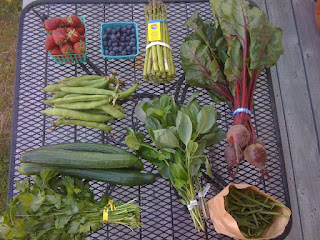Not everyone can brag that she has a mother who can butcher an animal. I, in fact, can. This piece of information came to light recently as family and friends brainstormed (over a few drinks) solutions to the deer problem plaguing my dad's organic garden. My dad can also shear a sheep, but that's just showing off.
I grew up in
Prunedale, sometimes called "
Prunetucky" by those not lucky enough to have grown up there. My parents, refugees of the Bay Area traffic, moved to their house in 1981 presumably to live a better life than suburbia could offer. And yes, my parents are of "that" generation: they're baby boomers and my dad went to Berkeley in during "those" years. So now you know why he has an organic garden, and you start to understand why my mom can butcher an animal.
As a kid I didn't really appreciate the fact that most of our food came from our own home. At one point we had lambs, chickens, pigs, goats and rabbits all of which sourced our family of table of 6. I remember trips to nearby
Watsonville for boxes of apples and canning tomatoes and jam in the hot August days of school vacation. And very little of it is unpleasant memory, except perhaps the slaughter of the lambs and the smell of just eviscerated chicken. I suspect that one experience in particular was the root cause of one brother's decision to become vegan.
All this homesteading was possible because my mom stayed at home during those years. As the four of us kids went through school, Mom eventually went back to work and we started buying more and more of our food. This was about the time that classmates at my private school started snickering and making
Prunetucky jokes, so I was a little relieved to be a little less "weird."
Trends are swinging back to making food at home. Last summer I spent several days making homemade jam, which I don't even like to eat. It is such a pleasure to make something from scratch and to give it away. More groups of people are starting to become aware of where their food comes from and are discovering alternatives such a meat cooperatives and
CSA programs. And I have to mention Jamie Oliver's Food Revolution, a show that premiered last week. America is becoming more and more aware of its food options and the impact of choices on our economy and environment. The Central Coast is a great place to try it out.
At my local farmers market, I can buy: produce of all kinds, beef, fish, eggs, cut flowers, baked goods, olive oil, sausages, orchids and other house and yard plants. Last week I spent $4.50 at my local farmers market and bought a beautifully fragrant basket of strawberries, a head of garlic and a bunch of rainbow Swiss chard. All that goodness still rang in cheaper than my typical fast food run. More importantly, my small purchase was a big personal step for me. I recently was diagnosed with
prediabetes, that ominous scourge of health problems that is unfortunately becoming wide spread in America. And I am determined to halt it in its tracks and reverse its path. This means not only understanding and valuing all the food alternatives but actually embracing them and taking action. And not just joining a gym, but going....to exercise, not just sit in the sauna. Right. Working on that one!
My other big step was to order a portion of a grassfed steer. For some time I have been considering this option, but only recently has the time been right to take action. Morris Grassfed Beef is raised just north of the
Monterey Peninsula, in the hills of San Juan
Bautista. At the time that I discovered it, I was looking for places to buy individual cuts of meat. I love the idea of supporting a local rancher who considers stewardship of the land as important as profit. Grassfed beef is also a healthier food product. In this scenario, you buy a steer, or a portion of one, and it is processed for you. You pick it up all bundled into neat butcher packages ready to enjoy. You don't have to witness the slaughtering and butchering, but you get a locally grown, healthy meat at very reasonable price.
As a family of 1, this scenario just didn't fit my lifestyle. I have neither the freezer space nor the capacity to eat 80 pounds of beef....and I do love beef! But, this year there is a
CSA style option which limits your take to one third three times a year- a much better option for people like me who don't have an extra freezer or a lot of mouths to feed. A friend of mine is a perfect partner to share a split half. Our individual cost will end up being around $300 for 40 pounds of grassfed beef.
Shopping for food this way is a huge change, even for someone like me who grew up understanding where food comes from. Most of all, the wait from now until the first pick up seems like ages away (July). But, in a life where fast food and convenience have already taken a huge toll it seems well worth it. What food changes (no matter how small) are you willing to make?
And as for the deer...what deer?






























